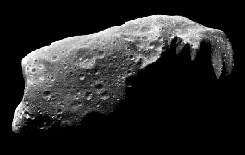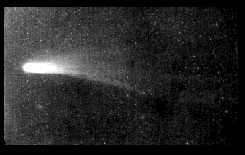
Asteroids
A large number of rocky and metallic objects orbit around the Sun but are too small to be considered full-fledged planets. These objects are known as asteroids or minor planets. Asteroids are material left over from the formation of the solar system. Some 4,000 numbered and named asteroids circle the Sun between the orbits of Mars and Jupiter. Scientists speculate that an additional 100,000 asteroids exist with diameters greater than 1 km. The asteroid belt appears to be divided into two very different regions. The inner asteroid belt (inside about 400 million km) is dominated by materials produced by strong heating and melting of the original proto-asteroids, and later fragmentation which has exposed their deep interiors. Beyond 400 million km the belt is dominated by dark objects rich in carbon, organic molecules, and sometimes water-rich clay minerals. These materials could not have survived significant heating, and asteroids in this region probably preserve much information about the formation of the solar system.A few asteroids in the inner portion of the asteroid belt are referred to as Mars-crossing or Amor asteroids, because the orbits of these objects cross that of Mars. In addition, well over 30 objects have been located that come in far enough to cross Earth's orbit. These Earth-crossing, or Apollo asteroids, usually measure a few kilometers in diameter, or less, with the largest measuring about 8 km across. Most Earth-crossing asteroids appear to originate in the main asteroid belt. There is evidence that Earth has been hit by asteroids in the past. One of the least eroded, best preserved examples is the Barringer Meteor Crater near Winslow, Arizona.

Comets
Most comets reside in the Oort cloud, some 50 to 100,000 AU in diameter around the Sun. Comet nuclei orbit in this frozen abyss until they are gravitationally perturbed into new orbits that carry them close to the Sun. Many of the nearly 900 recorded comets have orbital periods in excess of 200 years. Some comets pass through the solar system only once, while others have their orbits gravitationally modified by a close encounter with one of the giant outer planets. These latter visitors can enter closed elliptical orbits and repeatedly return to the inner solar system.The nucleus of a comet is an irregularly shaped, almost black aggregate of water ice, carbon, silicone, methane, and ammonia. The average size of the nucleus ranges from 1 to 10 km in diameter. As a nucleus falls inside the orbits of the outer planets, the volatile elements of which it is made gradually warm. By the time the nucleus enter the region of the inner planets, these volatile elements are boiling, forming a coma, or cloud-like "head" that can measure tens of thousands of kilometers across. The coma grows as the comet gets closer to the Sun.
The charged particles from the Sun, known as the solar wind, push on the coma blowing it back and forming "tails." One tail consists of gases and ions that blow directly back from the nucleus. The other tail contains dust particles that push back more slowly. As the nucleus orbits, the dust particles are left behind in a curved arc. Both the gas and dust tails point away from the Sun; in effect, the comet chases its tails as it recedes from the sun. The tail can reach 150 million km in length, but the total amount of material contained in this dramatic display would fit in an ordinary suitcase.